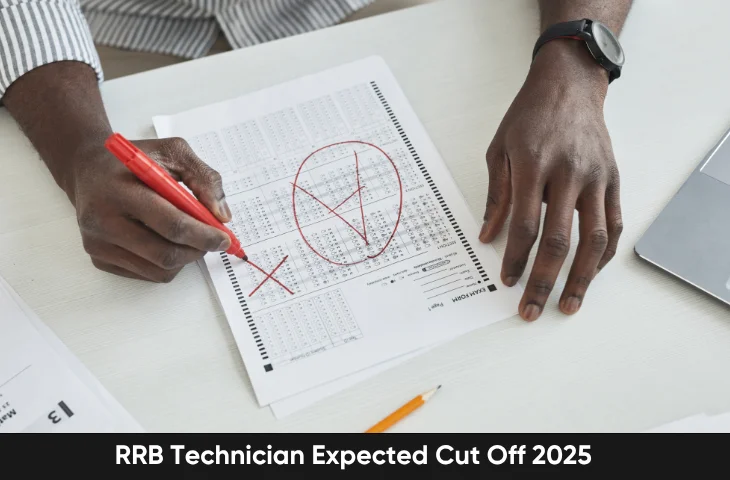Every year, thousands of candidates compete for RRB Technician posts across India. One of the most common questions among aspirants is: “What will be the RRB Technician expected cut off for 2025?” While the official cut-off will be declared only after the exam, analyzing previous years’ trends, normalization patterns, and difficulty levels can help aspirants set realistic targets and plan their preparation efficiently.
This article provides a detailed analysis of past trends, factors affecting cut-offs, and a forecast for RRB Technician 2025.
Understanding RRB Technician Cut-Offs
RRB Technician Cut-off marks are the minimum qualifying marks required in CBT-1 and CBT-2 to move to the next stage or secure final selection. The cut-off varies depending on:
- Category of the candidate: General, OBC, SC, ST, EWS
- Number of vacancies: More vacancies usually lower cut-offs; fewer vacancies increase them.
- Difficulty level of the exam: Harder exams may lower cut-offs, while easier exams raise them.
- Normalization process: Adjusts scores across different shifts, affecting the final qualifying marks.
RRB Techncian Previous Year Trends for CBT-1 & CBT-2
The following table shows the RRB Technician cut-off trends over the last few years for various categories. These are normalized scores for CBT-1 and CBT-2:
| Year | Stage of Exam | UR (General) | OBC | SC | ST | EWS | Notes |
| 2022 | CBT-1 | 72–75 | 70–73 | 60–63 | 55–58 | 68–70 | Normalization applied due to multiple shifts |
| 2022 | CBT-2 | 78–82 | 75–78 | 65–68 | 60–63 | 72–75 | Post-specific, technical knowledge considered |
| 2019 | CBT-1 | 70–73 | 68–70 | 58–60 | 55–57 | 66–68 | Slightly easier exam, higher cut-off |
| 2019 | CBT-2 | 76–80 | 73–76 | 64–67 | 60–63 | 70–73 | Trade-specific, moderately difficult |
Factors Influencing 2025 Expected Cut-Offs
There are various factors that will influence the RRB Technician Expected Cut Off 2025. Some of them are given below:
- Number of Candidates: A higher candidate-to-vacancy ratio can increase cut-offs.
- Exam Difficulty: If CBT-1 or CBT-2 is tough, normalized scores will adjust, potentially lowering the cut-off.
- Vacancy Count: More vacancies can reduce cut-off scores, while fewer vacancies push them higher.
- Category Reservation: Reserved categories have relatively lower cut-offs due to seat allocation policies.
- Normalization Across Shifts: Ensures fairness but may slightly boost or reduce scores depending on shift performance.
RRB Technician 2025: Expected Cut-Off (Forecast)
Based on previous years’ data, vacancy trends, and normalization patterns, the expected cut-off range for 2025 can be forecasted as follows:
| Stage | Category | RRB Technician Expected Cut Off 2025 |
| CBT-1 | UR (General) | 73–76 |
| CBT-1 | OBC | 70–73 |
| CBT-1 | SC | 60–63 |
| CBT-1 | ST | 55–58 |
| CBT-1 | EWS | 68–71 |
| CBT-2 | UR (General) | 78–82 |
| CBT-2 | OBC | 75–78 |
| CBT-2 | SC | 65–68 |
| CBT-2 | ST | 60–63 |
| CBT-2 | EWS | 72–75 |
Preparation Strategy Based on Expected Cut-Offs
The RRB Technician Selection Process involves various major stages. To qualify in each of the stages, candidates require solid preparation strategies. Some of them are given below:
- Target Higher Than Cut-Off: Aim for 5–10 marks above the expected cut-off to ensure safety.
- Focus on High-Weightage Topics: For CBT-1, prioritize Arithmetic, Reasoning, General Science, and Computer Basics. For CBT-2, concentrate on your trade-specific technical subjects.
- Practice Mock Tests: Attempt full-length tests under timed conditions to improve speed and accuracy.
- Revision Plan: Maintain a formulae, diagrams, and GK notebook for quick last-minute revision.
- Track Your Progress: Analyze previous mock test scores relative to expected cut-offs and adjust preparation focus.
Summary
We have given below the key points discussing the summary of the RRB Technician Expected Cut Off 2025. Check out the details for a quick overview:
- RRB Technician cut-offs are dynamic, influenced by difficulty, vacancies, category, and normalization.
- Historical trends show CBT-2 cut-offs are consistently higher than CBT-1 due to technical complexity.
- Expected cut-off for 2025: CBT-1 (General: 73–76), CBT-2 (General: 78–82).
- Candidates should aim above expected cut-offs, focus on high-yield topics, and consistently practice with mocks.
- Understanding past trends can help in setting realistic targets and reducing exam anxiety.
Predicting the RRB Technician expected cut off for 2025 helps aspirants plan their preparation strategically. While cut-offs depend on multiple factors, including normalization and shift difficulty, historical trends provide a reliable benchmark. Candidates should focus on maximizing scores, practicing regularly, and aiming for a buffer above expected cut-offs. With structured preparation and a clear understanding of past trends, clearing the RRB Technician exam becomes a much more achievable goal.
FAQs
Based on previous years’ trends, the expected cut-off for CBT-1 (General category) is 73–76, and for CBT-2 (General category) is 78–82. Cut-offs for reserved categories will be lower as per reservation norms.
Cut-offs are determined based on several factors, including exam difficulty, number of vacancies, category of the candidate, total candidates, and normalized scores across multiple shifts
It depends on the number of candidates and difficulty level of the exam. If the exam is easier than previous years, cut-offs may rise; if tougher, cut-offs may drop. Historical trends suggest CBT-2 generally has higher cut-offs than CBT-1.
Candidates can set their target scores slightly above expected cut-offs to ensure safety. Focusing on high-yield topics, practicing mock tests, and improving accuracy and speed can help surpass these thresholds.
Yes, normalization ensures fairness across multiple shifts. Scores may be adjusted slightly higher or lower depending on the relative difficulty of each shift, which in turn affects the final cut-offs.
- RRB Technician Study Plan for Working Professional, Know Details
- Top Reasoning Questions for RRB Technician, Download Free PDF
- Important General Science Questions for RRB Technician Exam
- RRB Technician Vacancy Zone Wise, Check Analysis Over Years
- RRB Technician Subject Wise Weightage, Know the Impact of PYP
- RRB Technician Exam Preparation Strategy 2025, Know Details

Hello! This is Arijit Dutta. I am a skilled Content Writer at Oliveboard with nearly 3+ years of experience in crafting engaging, informative, and exam-focused content for the Railways Domain. With a strong command of language and a keen understanding of learner needs, I contribute significantly to Oliveboard’s mission of delivering high-quality educational resources. Passionate about clear communication and continuous learning, I consistently create content that helps government job aspirants achieve their goals. Outside of work, I enjoy playing cricket and listening to music, which helps me stay balanced and creative in my professional journey.
